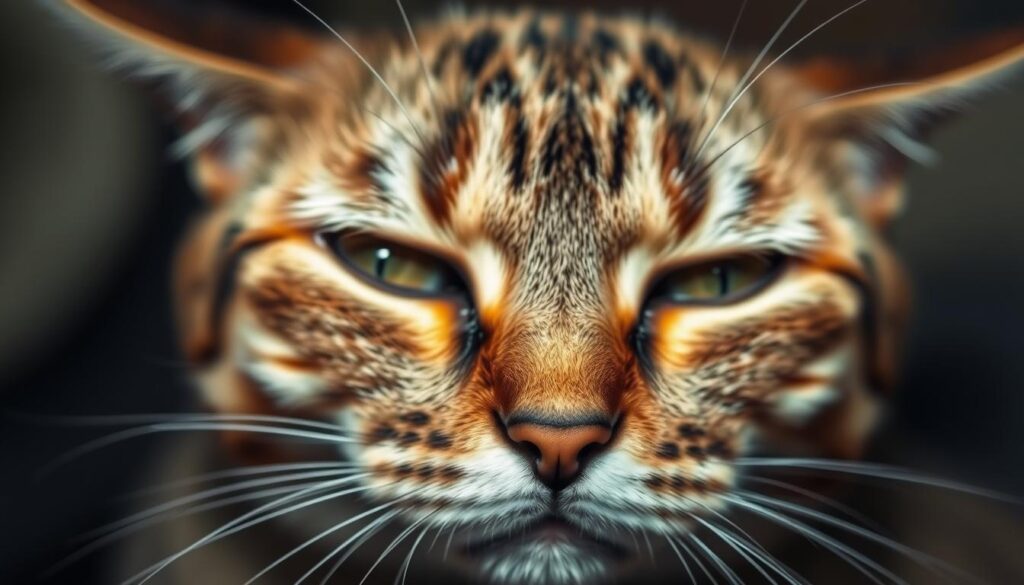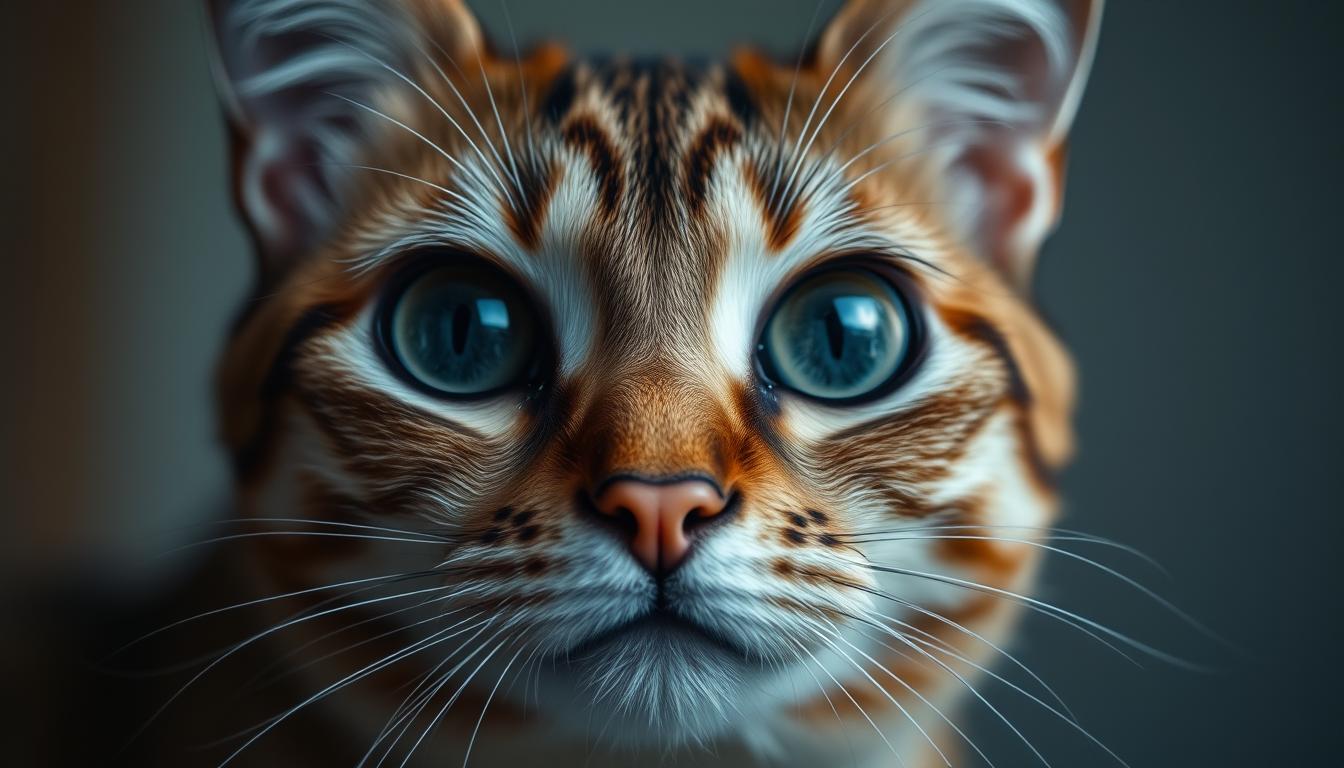do cats cry Ever seen your cat with watery eyes and thought, “do cats cry” like us? Seeing your cat’s fur with tears or hearing unusual sounds can worry you. Cats don’t cry like humans, but their eyes and actions tell a lot. Their tears often mean they’re in physical pain, but their behavior can show deeper feelings.
Understanding these signs helps you know what your cat needs. This guide looks into feline emotions, why their eyes get watery, and how to keep them happy. Let’s find out what their tears and cries really mean.
Key Takeaways
- Cats produce tears to lubricate eyes, not express sadness.
- Watery eyes may stem from allergies, infections, or age-related changes.
- Increased vocalizations or hiding can signal separation anxiety or stress.
- Consistent routines and vet care protect your cat’s emotional and physical health.
- HolistaPet’s CBD products help ease anxiety and promote calmness in cats.
The Truth About Feline Tears
Understanding do cats cry tears starts with biology. Cats don’t cry like humans do to show feelings. Their tears are for keeping their eyes moist, not for emotions. Let’s explore how it works.
Physical vs. Emotional Tears in Cats
Cats make tears to keep their eyes healthy. They don’t cry like humans do to show feelings. Do cats cry real tears? Yes, but these tears help their eyes stay moist and clean. They don’t cry because they’re sad or happy.
Tear Production in the Feline Eye
Cats have special tear ducts that help clean their eyes every day. This fluid has things that fight off germs. Here’s what you need to know:
- Normal tears keep eyes clear and shiny
- Excessive tearing may signal allergies or blocked ducts
- Breeds like Persians often have watery eyes due to facial structure
When Eye Discharge Is Normal vs. Concerning
Some eye moisture is normal. But watch out for these warning signs:
“Persistent redness, thick discharge, or squinting require a vet visit,” says the American Veterinary Medical Association.
Look out for:
- Swollen eyelids or cloudiness
- Green or yellow discharge
- Increased blinking or pawing at eyes
If your cat’s tears change suddenly, see a vet. Tears aren’t about emotions—so you need to find out why.
Do Cats Cry Like Humans?
Understanding if do cats cry like humans begins with science. Cats don’t cry like we do. Their tears help keep their eyes moist, not to show sadness. If you see tears, it’s usually because of health problems, not feelings.
- Meows and yowls signal needs or discomfort.
- Flattened ears or dilated pupils show fear or stress.
- Excessive vocalization may indicate separation anxiety or pain.
| Physical Causes of Tears | Emotional Signals |
|---|---|
| Eye infections | Increased meowing |
| Allergies | Hiding or aggression |
| Blocked tear ducts | Changes in eating/sleep patterns |
A 2015 study showed cats talk differently to people they know. Do cats cry like humans? No, but they communicate through meows and body language. If tears suddenly appear, it might be due to something like smoke. Or, it could be a health issue. Playing with your cat regularly and keeping a routine can help reduce stress.
The Science Behind Cat Emotions
To understand if do cats cry or why do cats cry, we must look at their brain. Cats feel emotions through special pathways in their brain. These pathways help them react to the world around them.
How Cats Process Emotions
Cats use the limbic system to process emotions. This part of the brain handles fear, pleasure, and stress. Unlike humans, cats show their feelings through actions, like purring when they’re calm or hiding when they’re stressed. Their feelings are based on instinct and what they’ve learned.
The Feline Limbic System
The limbic system controls a cat’s emotional drives. When a cat acts scared or curious, it’s because of this system. Studies show cats grieve when they lose a companion by sleeping more or avoiding activities they usually enjoy. This is similar to how dogs grieve.
Research on Cat Emotional Intelligence
“Cats adapt their behavior based on your tone and facial expressions,” says recent research.
- A study of 412 cats found grieving cats ate 30% less and hid 50% more after losing a pet sibling.
- Cats recognize human emotions through micro-expressions, adjusting their behavior to comfort owners.
Research shows cats in over 40 million U.S. households form strong bonds. These bonds affect their well-being. Their emotional intelligence helps them interact with you and their surroundings.
Signs Your Cat Might Be Emotionally Distressed
Do cats cry when they are sad? Cats don’t cry like humans, but their actions and body language show how they feel. Look out for these signs to help your cat feel better.
Behavioral Changes to Watch For
- Increased hiding or isolation
- Sudden aggression or hissing
- Loss of interest in favorite toys or activities
- Changes in eating or litter box habits
Vocalizations That Might Indicate Sadness
Cats in distress might meow excessively, yowl, or make high-pitched sounds. Nighttime crying often means they’re anxious, especially after big changes like a new pet or move. A study found that stress makes 70% of cats more vocal.
Body Language Cues of an Unhappy Cat
| Sign | Meaning |
|---|---|
| Flattened ears | Fear or submission |
| Dilated pupils | Stress or anxiety |
| Arched back or puffed fur | Feeling threatened |
| Lethargic posture | Depression or illness |
If your cat shows these signs, check their environment for stressors like loud noises or changes. Sudden changes or losing a pet friend can upset them. Also, take them to the vet regularly to check for health problems like blocked tear ducts or infections.
Medical Reasons Why Cats Have Watery Eyes
Cats don’t cry tears from emotion, but watery eyes can signal health issues. Do cats cry tears? No—but their tears may increase due to physical causes. Here’s what to watch for:
- Allergies: Dust, pollen, or household cleaners can irritate eyes, triggering tear overflow.
- Infections: Bacterial or viral infections like conjunctivitis cause redness and watery discharge.
- Blocked ducts: Congenital issues or injuries can trap tears, leading to constant overflow.
- Breed traits: Flat-faced breeds (Persians, Himalayans) often face eyelid deformities like entropion, which scratch the cornea and cause tearing.
- Age-related changes: Older cats may develop cataracts or glaucoma, which strain eyes and increase tear production.
If your cat’s eyes stay watery for 24 hours or more, contact a vet. Conditions like uveitis or corneal ulcers need prompt care to avoid vision loss. Ask your vet about the Schirmer Tear Test to rule out dry eye syndrome. Remember, why do cats cry with watery eyes? It’s rarely emotional—it’s often a sign to seek help.
“Persistent tearing isn’t normal. Early intervention prevents serious complications like infections spreading.” —Dr. Jane Foster, Feline Ophthalmologist
Do Cats Cry When They Are in Pain?
Cats don’t cry tears when they’re in pain, but they might make sounds to show they’re upset. It’s important to understand how they show they’re in discomfort. They might hide their pain, but changes in how they act can tell us what they need. 
How Cats Express Physical Discomfort
Cats don’t always show pain, but there are clues. Look for these signs:
- Increased meowing or yowling
- Refusal to move or limping
- Loss of appetite or weight loss
- Flattened ears or dilated pupils
- Overgrooming or neglecting fur
| Sign | Acute Pain | Chronic Pain |
|---|---|---|
| Vocalization | Sudden meows after injury | Increased whining over weeks |
| Appetite | Refusal to eat | Slow decline in food interest |
| Movement | Limping from injury | Slowed mobility from arthritis |
When to Contact Your Veterinarian
Get help right away if your cat shows:
- Unusual vocalizations lasting more than 24 hours
- Refusal to eat for 24 hours or more
- Signs of distress like panting or aggression
- Visible limping or trouble moving
Cats feel pain like we do, but they hide it. Spotting pain early can help a lot. Trust your gut—any changes in behavior mean they need help.
Why Do Cats Cry at Night?
Cats crying at night often comes from their natural instincts and the environment. They don’t cry like humans do, but their sounds can still wake you up. To understand their behavior, we need to look at their biological rhythms.
Nocturnal Behavior Explained
Cats are crepuscular, meaning they’re most active at dawn and dusk. This instinct makes them active at night, including when they want to play. Experts say boredom is the main reason for their nighttime crying. Cats that aren’t spayed or neutered might also cry because they want to mate.
“Cats thrive on routine. Disruptions like irregular feeding or lack of playtime can amplify nighttime vocalizations.”
Addressing Nighttime Vocalizations
To cut down on do cats cry at night problems, try these steps:
- Play with them for 15–20 minutes before bed to wear them out.
- Use puzzle feeders to keep them busy and satisfy their hunting drive.
- Don’t feed them when they meow—it just makes them meow more.
- Look for health problems like high blood pressure or hyperthyroidism, which can make them meow a lot.
| Reason | Solution |
|---|---|
| Boredom | Install window perches or rotating toys to stimulate interest. |
| Separation anxiety | Leave calming music or pheromone diffusers to soothe them. |
| Medical issues | Schedule a vet visit if crying intensifies or pairs with lethargy. |
Older cats might meow more because of age-related brain changes. Keeping their routine consistent helps. Never scold them—instead, use toys or safe activities to keep them busy at night.
How to Comfort an Emotionally Distressed Cat
Understanding why do cats cry starts with knowing their emotional needs. A safe place and caring actions can help them feel better. Here’s how to support your feline friend:

Creating a Secure Environment
Begin by creating safe spots. Cats that do cats cry when they are sad often hide in quiet places. Give them:
- Covered beds or cardboard boxes for hiding
- Elevated perches for observation spots
- Familiar blankets with your scent
Studies show 30% of cats get stressed when new pets arrive. Use pheromone diffusers like Feliway. It helps 70% of multi-cat homes feel calmer.
Bonding Activities That Reduce Stress
Do calming activities together:
- Play with feather toys for 10-15 minutes daily
- Try slow-blink communication to build trust
- Use a brush for short grooming sessions
Classical music at 50dB can calm 80% of cats. Try playlists made for feline comfort.
When Professional Help Might Be Needed
See a vet if your cat:
- Has lost appetite for over 24 hours
- Shows bald patches from over-grooming
- Acts aggressively
| Stress Trigger | Solution | Effectiveness |
|---|---|---|
| New family member | Introduce scents gradually | Reduces anxiety by 40% |
| Separation anxiety | Leave on soft music | Reduces symptoms by 20% |
| Multi-cat conflicts | Provide separate feeding stations | Reduces aggression by 60% |
Keep routines consistent—like regular feeding and playtimes. This helps 75% of cats feel less stressed. Always think about what your cat needs, whether it’s comfort or alone time.
Common Misconceptions About Cats and Crying
Ever wondered do cats cry real tears or do cats cry like humans? Many myths exist about how cats show emotions. Let’s clear up these misunderstandings to help care for your cat better.
“Cats lack the emotional tear response humans have,” says Dr. Jane Smith, a veterinary ophthalmologist at Feline Health Institute. “Their tears are usually a sign of health issues, not sadness.”
Here are key misconceptions to avoid:
- Watery eyes in cats rarely signal sadness. Instead, they often stem from allergies, infections, or blocked tear ducts.
- Purring doesn’t always mean contentment. Cats also purr when stressed or in pain, as shown by a Applied Animal Behaviour Science study.
- Meowing is mainly directed at humans, not other cats. Felines primarily communicate with body language.
Breed-specific traits can also lead to confusion. Persians, for example, often have eye discharge due to flat faces, not emotional distress. A 2023 survey of 400 cat owners found 60% misinterpreted such physical traits as sadness.
If your cat shows prolonged lethargy or changes in appetite after losing a companion, they might grieve—but not through tears. Behavioral shifts, not tears, signal distress. Always consult a vet if eye discharge lasts over 24 hours. Understanding these truths helps you provide better care for your cat’s physical and emotional needs.
Conclusion: Understanding Your Cat’s Emotional Communication
Cats don’t cry like humans do, but they show their feelings in other ways. They use body language and sounds to communicate. For example, Siamese and Abyssinian cats are very vocal, using meows and yowls to get attention.
It’s important to understand what your cat is trying to tell you. Happy cats have ears up, while stressed cats have ears back or wide eyes. A slow blink or an upright tail means they’re feeling safe. But a tucked tail or hiding might mean they’re scared or upset.
Even simple actions like kneading or bringing you “gifts” show trust. Cats also have a special way of smelling called the Flehmen response. Purring can be a sign of happiness, but it can also mean they’re in pain. So, if your cat starts purring differently, it’s a good idea to take them to the vet.
By paying attention to your cat’s signals, you can build a stronger bond. Give them puzzle toys and places to climb to help them feel less stressed. If they seem upset or don’t want to eat, get them checked by a vet right away. Enjoy their unique ways of showing love, like head bumps or just being quiet with you. Learning their language helps you meet their needs and understand them better.
FAQ
Do cats cry emotional tears like humans do?
Why do cats cry?
Do cats cry tears?
What causes a cat’s eyes to be watery?
Do cats cry when they are sad?
How can I tell if my cat is in pain?
Why do my cats cry at night?
What should I do if my cat seems emotionally distressed?
Are there common misconceptions about cats and crying?
Source Links
- Do Cats Cry? | PrettyLitter – https://www.prettylitter.com/blog/do-cats-cry?srsltid=AfmBOoqc8acLQohoH5eKbv23buhkB5K6auXgDQrKZIeeg3a53LuwEq_4
- Cat Emotions: How to Interpret Your Feline’s Feelings – https://www.holistapet.com/blogs/cat-care/emotions?srsltid=AfmBOor-IBJd3m8VHl-PmxvH74c9iIvsf_vZ5NjoPKBOWXA3b_kwosZS
- Do Cats Cry? – https://www.petmd.com/cat/general-health/do-cats-cry
- Can Cats Cry? Understanding Cat Tears and Emotions – https://noblevetclinic.com/blog/can-cats-cry-understanding-cat-tears-and-emotions
- Do Cats Cry? | PrettyLitter – https://www.prettylitter.com/blog/do-cats-cry?srsltid=AfmBOoo6FrVxk2WgEGK671sLvnLbYTwsiokVLZDmCMY4hX-L0_2SluWs
- Do Cats Cry? | PrettyLitter – https://www.prettylitter.com/blog/do-cats-cry?srsltid=AfmBOorYsSD_DIwgByhKcXaOBv5404ci69n9SUZ9PKT9m9S-isEbUHvi
- Cry Fur Baby! Do Cats Cry? – https://www.trustedhousesitters.com/blog/pets/do-cats-cry/
- Cat Crying: Why Does My Cat Meow So Much? – Total Vet – https://total.vet/cbd-cat-crying/
- Do Cats Feel Grief? – https://www.psychologytoday.com/us/blog/psychology-tomorrow/202408/do-cats-feel-grief
- Can Cats Sense Sadness? A Guide to Cats’ Emotional Recognition – https://www.kinship.com/cat-behavior/can-cats-sense-sadness
- Do Cats Cry? | PrettyLitter – https://www.prettylitter.com/blog/do-cats-cry?srsltid=AfmBOopstJyt7TjtlNQ3z1mxWCPQBtR0YdaDJ-MxpUBu9L1DLriM7Qx1
- Cat Emotions: How to Interpret Your Feline’s Feelings – https://www.holistapet.com/blogs/cat-care/emotions?srsltid=AfmBOoorTRQOnlvulRur9AZwEkuWPP9QhY8gv_0B58PChihrB5tsS3P-
- Warning Signs Your Cat Is Crying for Help – https://petcube.com/blog/cat-is-crying-for-help/
- Watery Eyes in Cats: Common Causes and Treatments – https://thevets.com/resources/pet-symptoms/watery-eyes-in-cats/
- Do Cats Cry? | PrettyLitter – https://www.prettylitter.com/blog/do-cats-cry?srsltid=AfmBOoo9p5RJk6yjJGTK0oec198xi-mFiQiygCV5Fpa9dwy4leGQzlrL
- Cat Eye Problems: Common and Advanced Conditions – https://thevets.com/resources/pet-conditions/cat-eye-problems/
- How to Tell If a Cat Is in Pain: 8 Signs | Great Pet Care – https://www.greatpetcare.com/cat-health/how-to-tell-if-a-cat-is-in-pain/
- How to Tell if a Cat Is in Pain: Behavioural and Physical Signs – https://pawesomecats.com/signs-cat-in-pain/
- Why Does My Cat Cry at Night? – https://www.mentalfloss.com/posts/why-does-my-cat-cry-at-night
- Do Cats Cry? | PrettyLitter – https://www.prettylitter.com/blog/do-cats-cry?srsltid=AfmBOoooUKiKg24pdhU-U5HFNP92HRcZBCtXRRUWL38mw8JNg_VBmIXz
- Comforting a Stressed Cat: Expert Tips for a Calmer Feline – https://victoriaroadvet.com/making-a-stressed-out-cat-feel-comfortable/
- Stress in cats – https://icatcare.org/articles/stress-in-cats
- What is Cat Anxiety & What Can You Do to Settle Your Cat? | Purina – https://www.purina.co.uk/articles/cats/behaviour/understanding-cats/cat-anxiety
- Do Cats Feel Grief? New Study Notes Behavioral Changes in Felines Whose Companion Animals Die – https://www.womansworld.com/life/animals/do-cats-feel-grief-new-study-notes-behavioral-changes-in-felines-whose-companion-animals-die
- Cat Purring – Why Do Cats Purr? What Does It Mean When a Cat Purrs? – https://animalhotels.com/gb/blog/cats/cat-purring-why-do-cats-purr-what-does-it-mean-when-a-cat-purrs
- Cat Behavior Archives | Little Big Cat – Dr. Jean Hofve – https://littlebigcat.com/category/cat-behavior/
- Understanding cat behavior and feline language – https://www.humaneworld.org/en/resources/understanding-cat-behavior-and-feline-language
- National Cat Lover’s Month: Decoding Your Kitty’s Love Language – https://shadowcreekvet.com/services/cats/blog/national-cat-lovers-month-decoding-your-kittys-love-language
